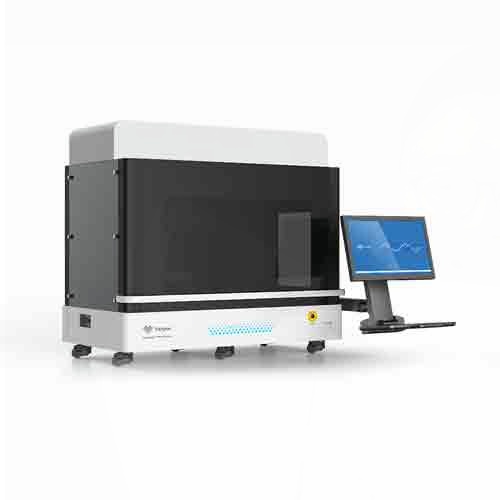Salmonella
Salmonella is a genus of Gram-negative bacteria belonging to the family Enterobacteriaceae. These bacteria are responsible for common foodborne infections in humans, causing a disease known as salmonellosis.

So, How can we detect the salmonella ?
Salmonella can be detected using various laboratory methods likeCulture-based methods, Polymerase Chain Reaction (PCR), Quantitative PCR (qPCR), Immunoassays, Next-Generation Sequencing (NGS).
we are only interested in qPCR and NGS.
Polymerase Chain Reaction (PCR):
is a widely used molecular technique for detecting Salmonella. Here's how it can be used for Salmonella detection:
1. Design primers and probes: Specific primers and probes are designed to target unique regions of the Salmonella DNA. These primers and probes should be specific to Salmonella and not cross-react with other bacteria or contaminants.
2. Sample preparation: The sample, such as a clinical specimen, food sample, or environmental swab, is collected and processed to extract the DNA. Various DNA extraction methods can be used to isolate the genetic material from the sample.
3. qPCR setup: The qPCR reaction is prepared, which typically includes the DNA template, primers, probes, and a qPCR master mix containing DNA polymerase, dNTPs, and other reaction components. The master mix may also contain fluorescent dyes or probes specific to the qPCR platform being used.
4. Amplification and detection: The qPCR reaction is subjected to a series of temperature cycles in a qPCR machine. These cycles include denaturation, annealing, and extension steps. During the amplification cycles, the DNA template is denatured, and the primers anneal to the target DNA sequence. The DNA polymerase then extends the primers, creating multiple copies of the target DNA sequence. As the DNA is amplified, the fluorescent probes or dyes emit fluorescence signals that are captured by the qPCR machine.
5. Data analysis: The qPCR machine continuously monitors the fluorescence emitted during each cycle. The fluorescence intensity is measured and recorded. The data obtained from the qPCR machine can be analyzed using specific software or algorithms to determine the presence or absence of Salmonella DNA in the sample. The cycle threshold (Ct) value, which represents the cycle number at which the fluorescence signal crosses a predetermined threshold, can be used as an indicator of the initial amount of Salmonella DNA in the sample.
6. Result interpretation: The presence of a significant increase in fluorescence signal above the threshold during the amplification cycles indicates the presence of Salmonella DNA in the sample. The Ct value can provide information about the quantity of Salmonella DNA present in the sample, with lower Ct values indicating higher amounts of Salmonella DNA.
the use of this technique requires reagents which come together in a kit called Salmonella qPCR Kit
Next-Generation Sequencing (NGS)
Detection of Salmonella using Next-Generation Sequencing (NGS) involves sequencing the entire bacterial genome to identify and characterize the presence of Salmonella in a sample. Here's an overview of the NGS-based detection process:
1. Sample preparation: The sample, such as a clinical specimen, food sample, or environmental swab, is collected and processed to extract the bacterial DNA. Various DNA extraction methods can be used to obtain high-quality genomic DNA.
2. Library preparation: The extracted DNA is fragmented and adapters are ligated to the fragments. This step involves preparing a sequencing library, which contains the DNA fragments ready for sequencing. Library preparation may involve different techniques, such as DNA fragmentation, end repair, adapter ligation, and PCR amplification.
3. Sequencing: The prepared library is loaded onto the NGS instrument for sequencing. Various NGS platforms, such as Illumina, Ion Torrent, or PacBio, can be used for Salmonella detection. The sequencing process generates millions of short DNA sequences (reads) from the library.
4. Data analysis: The generated sequencing data undergoes bioinformatics analysis to identify and characterize Salmonella. The analysis involves several steps:
- Read mapping: The sequencing reads are aligned or mapped to a reference genome, typically a known Salmonella genome sequence. This step helps identify the presence of Salmonella-specific sequences in the sample.
- Variant calling: Single nucleotide polymorphisms (SNPs), insertions, deletions, and other genetic variations are identified by comparing the mapped reads to the reference genome. This step allows for the detection of specific Salmonella strains or serovars.
- Phylogenetic analysis: The identified variants and genetic markers are used to construct a phylogenetic tree, which provides information on the relatedness and evolutionary relationships between different Salmonella strains or isolates.
- Serotyping and antimicrobial resistance prediction: NGS data can be further analyzed to determine the serotype of Salmonella based on the presence or absence of specific genes or alleles. Additionally, the presence of antimicrobial resistance genes and mutations can be assessed, providing insights into potential drug resistance profiles.
5. Result interpretation: The analysis results provide information on the presence of Salmonella, its specific strain or serovar, genetic variations, and potential antimicrobial resistance profiles. This information is valuable for outbreak investigations, surveillance, and understanding the epidemiology of Salmonella infections. https://pubmed.ncbi.nlm.nih.gov/31945388/

